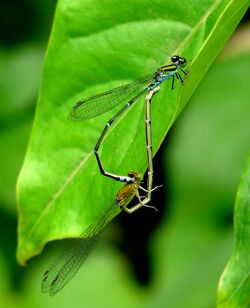Biology:Pseudagrion
| Pseudagrion | |
|---|---|

| |
| Pseudagrion indicum | |
| Scientific classification | |
| Domain: | Eukaryota |
| Kingdom: | Animalia |
| Phylum: | Arthropoda |
| Class: | Insecta |
| Order: | Odonata |
| Suborder: | Zygoptera |
| Family: | Coenagrionidae |
| Genus: | Pseudagrion Selys, 1876[1] |
Pseudagrion is the largest genus of damselfly in the family Coenagrionidae,[2] with over 140 species. Its range includes most of Africa, much of Asia, and Australia. Africa holds most of the diversity with almost 100 species. It has occupied most of the freshwater habitats in its range, and dominates damselfly communities in habitats as different as desert pools, equatorial rainforests and montane streams.[3]
On the African continent, the genus comprises two distinct groups: The "A-group" has about 45 species - they are predominantly highland species and males lack spines on S10; The "B-group" has about 25 species - mainly from lowlands and males have spines on S10.[4] A third Afrotropical group comprises 31 species from the forest streams of Madagascar and the Comores.[3]
Species
The genus Pseudagrion includes the following species:[5]
Gallery of species without an article
References
- ↑ Selys-Longchamps, E. (1876). "Synopsis des Agrionines, (suite de genre Agrion)" (in French). Bulletin de la Classe des Science, Académie Royale de Belgique 42: 490–531, 952–991 [490]. https://www.biodiversitylibrary.org/page/34716922.
- ↑ "Genus Pseudagrion Selys, 1876". Australian Biological Resources Study. 2012. https://biodiversity.org.au/afd/taxa/Pseudagrion.
- ↑ 3.0 3.1 Dijkstra, Klaas-Douwe B.; Groeneveld, Linn F.; Clausnitzer, Viola; Hadrys, Heike (April 2007). "The Pseudagrion split: molecular phylogeny confirms the morphological and ecological dichotomy of Africa’s most diverse genus of Odonata (Coenagrionidae)". International Journal of Odonatology 10 (1): 31–41. doi:10.1080/13887890.2007.9748286.
- ↑ Dijkstra, K.-D.B.; Clausnitzer, V. (2014). The dragonflies and damselflies of eastern Africa. Tervuren: Royal Museum for Central Africa. ISBN 978-94-916-1506-1.
- ↑ "World Odonata List". University of Puget Sound. http://www.pugetsound.edu/academics/academic-resources/slater-museum/biodiversity-resources/dragonflies/world-odonata-list/. Retrieved 11 August 2010.
- ↑ 6.00 6.01 6.02 6.03 6.04 6.05 6.06 6.07 6.08 6.09 6.10 6.11 6.12 6.13 6.14 6.15 6.16 Samways, Michael J. (2008). Dragonflies and Damselflies of South Africa. Pensoft. ISBN 954-642-330-0.
- ↑ 7.0 7.1 7.2 7.3 7.4 7.5 Günther Theischinger; John Hawking (2006). The Complete Field Guide to Dragonflies of Australia. CSIRO Publishing. ISBN 0-643-09073-8.
- ↑ Boudot, J.-P.; Clausnitzer, V.; Suhling, F.; Dijkstra, K.-D.B. (2016). "Pseudagrion nubicum". IUCN Red List of Threatened Species 2016: e.T60028A85433445. doi:10.2305/IUCN.UK.2016-3.RLTS.T60028A85433445.en. https://www.iucnredlist.org/species/60028/85433445. Retrieved 17 November 2021.
Wikidata ☰ Q1309867 entry
 |


